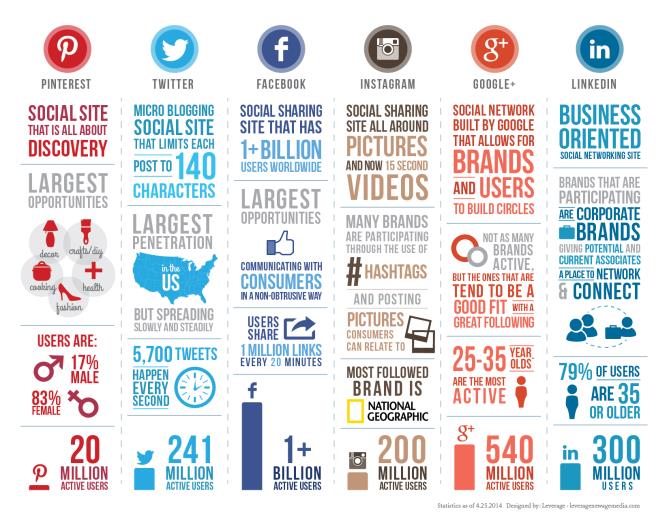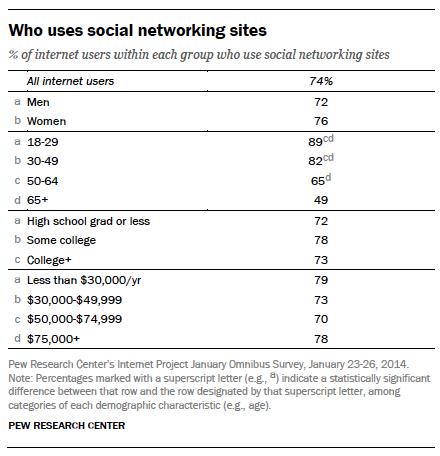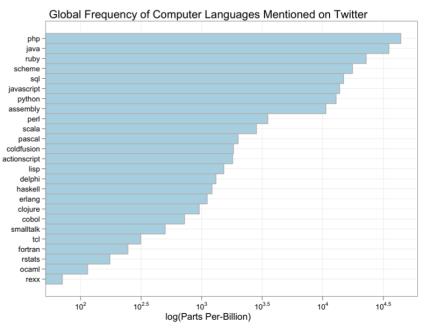If you have even the slightest amount of entrepreneurial spirit, then you have obviously noticed the rapid pace at which social media has taken over the entire globe. The future of professional social network website development seems to be in a constant state of change, with more social networks popping up out of nowhere almost daily and social platforms increasing functionality at an incredible pace.
The infographic below from www.leveragenewagemedia.com, highlights some very interesting stats for six of the most popular social networks on the web. Google+ weighs in with over five-hundred million users, LinkedIn has three-hundred million and even Pinterest, a relatively small network, has a captive audience of more than twenty-million users.

With numbers like that, it doesn't take a marketing guru to figure out the potential profit of capturing a fraction of the social media audience is almost unlimited. Of course, that is why so many professional social network website developers arrived on the scene over the last several years.
Barely Scratched the Service or Market Saturation?
Social networks come in many different flavors offering different environments, features and reasons users become engaged with a particular platform, and more importantly stay engaged. If you are planning to enter the professional social network website development market, as either a developer or the C.E.O behind the developer of a site, you will need an excellent business plan.
Basically, seven major categories of social network websites exist.

Opinions on the long term viability of social networks varies quite a bit from one expert to another. One look at this chart from Statista.com projecting over 2 billion users of social media by 2016 makes the social media market appear to have unlimited potential. However, a look at this listing from Wikipedia.com, with most of the social networks that are in existence today globally, makes it clear the market is ultra-competitive.
Success in the professional social network website development arena, requires a fundamentally sound business plan and the ability to scale operations at a moment's notice.
Management of the project must be highly effective, from the initial idea of the 2 or 3 features which will set your social network experience apart from the crowd, to the site development and application design process, all the way to flawless execution in every area.

Source: Pew Research Internet Project 2014

Source: Pew Research Internet Project 2014
Social Media-Be All Things to All People
The graphics statistics from Pew Research above show amazing consistency of social media network use by almost all ages, all income ranges, education levels and gender. And here is one more great resource with fresh social media stats.
If you are a marketer at heart this might make you begin to salivate just thinking of the opportunity that awaits. However, if you are more of a "planner" who tries to find solutions for problems before they happen, this might make you very nervous.
Why?
While the statistics are through the roof in terms of user engagement, this also means your social network better provide exceptional value, a flawless and dynamic user experience, and basically be all things to all people. That is not exactly a simple barrier to cross in any market.
On top of that, keep in mind we live in a world of convenience now. Your social platform will have to rate extremely high on the ease of use scale, include robust sharing options that are integrated with PC's, Mac, Android, iOS, tablets, photo file formats, video file formats and players, among many other important items. All of that while providing an endless flow of captivating content and some unique features that keep your users engaged for the long term.
Social Site Development-Dynamic Performance, Ultra-Flexible Functionality, Secure and Highly Efficient
Professional social network website development needs to bring many different components together to work as one in order to have a full featured social platform that is secure, responsive to a large number, capable of handling the workload constantly and provides the functionality needed for moving different file formats efficiently.
Approaching the core design for a social media network there are 8 core functions that all need to be addressed. If you are dealing with a smaller project, then there is no shortage of prepackaged platforms available that might work. However, when it comes to a full suite of social media functionality, you are talking about an enterprise level solution that needs to be custom built a piece at a time.
- Secure data and user/site information
- Flexible and scalable design platform
- Integration with multiple devices
- App length of usability
- Media sources and communications
- Consistent performance and real-time tuning
- Ease of use and access
- Service capabilities
At infoq.com they actually have a video posted of Nick Shrock, an engineer at Facebook. He discusses how the architecture of Facebook has evolved over the years. It is an interesting rundown on the evolution of web development in social media networks.
Core Architecture for Professional Social Network Website Development
The architecture of a social networking website should offer scalability, performance, flexibility and security for visible "front end" operations and capabilities. It should also offer the user a seamless interface that is fast, responsive and able to provide a long list of capabilities.

Source blog.revolutionanalytics.com
Facebook utilizes several tools for its core infrastructure, but there is one that is the foundation and the rest of the system is built upon. It is called LAMP for short, which really means a combination of Linux, Apache Web Server, PHP programming language and a MySQL database.
MySQL is a very popular database model that has been widely used for years. It is very flexible, secure and offers a high degree of functionality and scalability.
PHP is a core programming language that has been around forever and offers functionality, a high level of compatibility and security. PHP also integrates well with other code, which is important with a project of this size. Other types of code and various technologies and software will have to be utilized for additional features and to optimize performance of the site.
All of these components are well known for being flexible and able to perform in environments with complex configurations. Linux and Apache Web Server round out the group. This is a nice combination of open-source solutions that function well with other components introduced into the platform and provide a solid foundation, particularly for an enterprise level professional social network website development project.
Once you settle on a LAMP foundation for the site, you are just getting started. It is very likely before you get too much further into the social network website development, HTML and CSS will come into the picture as necessary components. While it does make the project a little more difficult at the beginning by choosing an open-source solution with individual parts, later on down the road it will provide some real benefits.
Benefits such as the ability to scale the functionality and performance of the site to meet increasing demands 3 or 4 years down the road. This architecture also allows for making significant additions and subtractions to the overall system without having to rip apart the core. While it can be done, tearing apart a system that has worked well for multiple years and operated at a high level of performance, is asking for trouble.
So, you are now well on the way to having the next Facebook! A few more decisions and some smart project management, your social media empire will be up and running in no time.
How did you build your latest site? What is your favorite site architecture to work with? Leave us your comments and let us know.
